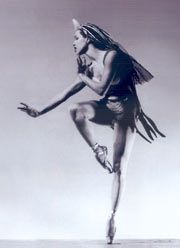Author's Note: I wrote this obituary last year, which appeared on April 15, 2013, as part of my weekly Indian news round-up at Daily Kos. Death and loss have been on mind for rather obvious reasons, but the Firebird has been dancing through my thoughts for days now. It seemed appropriate to remember her today, as well.
 When I was a little girl, one of the many things I wanted to be when I grew up was a ballerina. So did a lot of the other little girls I knew. But in my case, I didn't want to be just a ballerina; I wanted to be one specific ballerina. I wanted to be the next Maria Tallchief. I loved everything about her — her stunning beauty, her almost liquid grace, her powerful-sounding name, her insistence on maintaining her identity. And I loved the hope she represented: that, at a time when Indians were invisible to the larger world except as Hollywood Western stereotypes, a little Indian girl maybe, just maybe, could grow up to be anything she wanted.
When I was a little girl, one of the many things I wanted to be when I grew up was a ballerina. So did a lot of the other little girls I knew. But in my case, I didn't want to be just a ballerina; I wanted to be one specific ballerina. I wanted to be the next Maria Tallchief. I loved everything about her — her stunning beauty, her almost liquid grace, her powerful-sounding name, her insistence on maintaining her identity. And I loved the hope she represented: that, at a time when Indians were invisible to the larger world except as Hollywood Western stereotypes, a little Indian girl maybe, just maybe, could grow up to be anything she wanted.Born in Fairfax, Oklahoma, on January 24, 1925, to an Osage father and a Scots-Irish mother, Elizabeth Marie Tall Chief was already dancing by age three. She began dancing professionally in 1942, when she joined the Ballet Russe dance company. At that time, Americans regarded Russians as the only dancers capable of "true" ballet, and so dancers of all nationalities took "Russian" names in an attempt to seem more "authentic." The year she joined, Ballet Russe officials asked Ms. Tallchief to change her name from Marie Tall Chief to Maria Tallchieva. Determined to maintain her Osage identity, the 17-year-old refused, although she did consent to altering her name to Maria and to merging her two-word surname into one word.
Ms. Tallchief broke barriers throughout her career. She was the first Native prima ballerina, and in 1944, began working with famed Russian choreographer George Balanchine. Obituaries widely refer to her as his "muse," and in 1946, she also became his wife. That same year, he cast her in his production with the Paris Opera Ballet, making her not only the first Indian, but the first American, ever to perform with the dance company. In 1947, when her contract with Ballet Russe expired, she followed Balanchine to New York to become one of the founding dancers of the New York City Ballet Company. Her talent and presence were such that she made the Firebird, the Swan Queen, and the Sugarplum Fairy her own, creating archetypes for future generations of aspiring dancers. She continued to dance with the New York City Ballet until her retirement in 1966.
Her marriage to Balanchine had long since ended, as had her second marriage to an aviator. In 1956, she was married for the final time, to Henry "Buzz" Paschen, Jr., with whom she had a stepdaughter and a biological daughter. After retiring from dancing, she moved to Chicago, where she continued to break barriers. She founded the ballet company at the Lyric Opera of Chicago in the 1970s; in 1981, she and her younger sister, Marjorie Tallchief, co-founded the Chicago City Ballet.
Through it all, she never abandoned her identity. Her obituary in the Chicago Sun-Times is accompanied by a slideshow of photos from various stages of her life; among them is a 1997 photo, taken in her home in Chicago, of her standing next to a framed, very old black and white photograph of her great-grandfather, Big Heart. Today, there are statues in her honor in Oklahoma, and the Osage Nation gave her a traditional name, Wa-Xthe-Thomba, which reportedly translates into English as "Woman of Two Standards." To generations of little Indian girls around the country, perhaps the most significant standard she carried was the one labeled "hope."
Normally, I would say that, on April 11th, 2013, Maria Tallchief walked on. But in this case, I don't think it's really accurate. I think that, four days ago, the Firebird stood en pointe one last time, and then took flight.
Copyright Ajijaakwe, 2013, 2014; all rights reserved.

i worked with andre eglevsky during the 80s - and was also fortunate enough to see maria dance at lincoln center.
ReplyDeletehere is a youtube from 1954 of them dancing act II of swan lake...
http://youtu.be/f8zOg8HntPs
one more, just for you to enjoy!
ReplyDeletehttps://www.youtube.com/watch?v=0y_tWR07F7Y#aid=P8WsBVDaFZQ